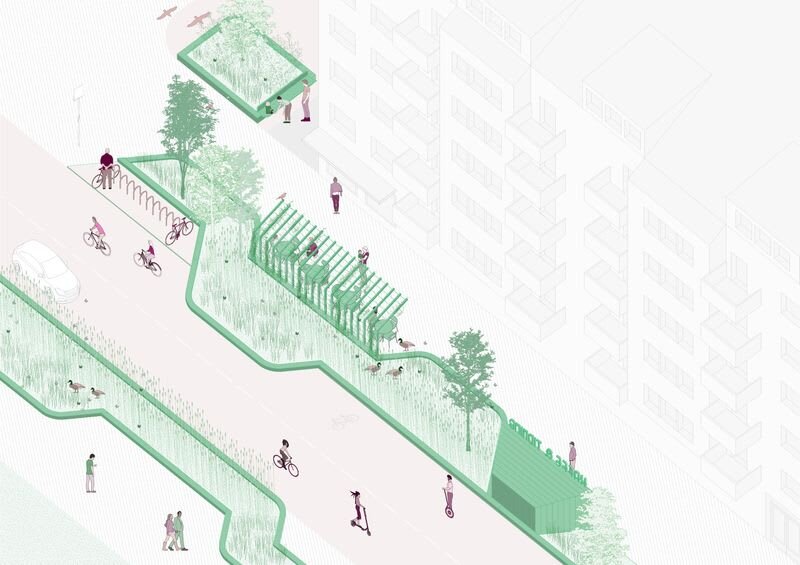Post-Covid Hyper Localised Planning Trends
Is medium and high density strata the ultimate urban planning model …
Trends towards more decentralised urban planning have [like many things] been accelerated due to Covid 19. So, as ideal urban living zones get smaller, are we heading towards building complex zones where medium and high-density #stratatitle buildings rule?
[5:00 minutes estimated reading time, 945 words]
Become a paid GoStrata Stak subscriber
Introduction
Today, I’m taking a shallow dive into the urban planning pool as an introduction to the impacts planning policies, trends and regulator choices can have on strata buildings and their stakeholders.
I’ve highlighted the idea before in my article ‘Does the key to better strata buildings lie in planning laws [and not strata title laws] ...’ that perhaps planning laws are more likely to hold the keys to better strata buildings than strata laws and even a cursory look at what strata buildings are being built and where reveals that it is driven more by zoning control changes and economic factors than any strata title focused policy or strategy.
So, anyone interested in the likely future of strata title buildings and issues or how to improve the experience of owning and living in strata buildings should watch urban planning trends.
This article is very superficial [so please don’t attack me urban planning experts] but, hopefully, shows how the newest post-Covid trend could impact strata title positively.
Decentralised urban planning trends
Post-war planning for cities, to the extent it existed at all, in western countries like Australia was mainly focused on urban sprawl. Cities spread out from the historic and/or commercial centres to fill the surrounding vacant, rural or semi-rural land with low-density housing.
Later, higher density centres within larger cities developed where secondary commercial, government or education operations were centred and higher density housing was created around those areas mostly driven by commercial factors [demand for lower-cost housing in those locations] rather than planning policies.
But by the late eighties and early nineties, local and state planning policies started to focus on increasing densities in specific parts of cities [mostly around existing public transport routes] so that a 60-minute city zone idea emerged. That’s the concept that someone can do most of the things they need within a 1-hour travel radius of their home [like work, education, shopping, health, recreation, entertainment, etc].
Over the last few decades, the size of that ideal city zone has shrunk steadily and so we’ve seen higher and higher densities in many parts of our cities.
So, just taking one source of urban planning reporting from Bloomberg City Lab we can see that in 2020 the prevailing ideal was the 15-Minute city as they reported in ‘The 15-Minute City—No Cars Required—Is Urban Planning’s New Utopia’ but now they are writing about the 1-Minute city as you can read about in ‘Make Way for the ‘One-Minute City’.
What’s a 1-minute city and why do we want or need it?
Well at this stage it’s just Sweden that’s working on such a concept called Street Moves [although it is on a national scale] which involves focusing on each street rather than groups of blocks like Barcelona’s superblocks plan and involves allowing local communities to become co-architects of their own streets’ layouts via workshops and consultations so that residents can control how much street space is used for parking, or for other public and private uses.
Here’s an example of the way that could occur in these before and after images.
Streetscape before Street Moves
Streetscape after Street Moves
And, whilst this micro and high localised development in urban planning is new, I can see how the localisation that we’re experiencing due to Covid 19 is a further catalyst for its development, relevance and popularity.
After all, if we can’t travel outside Covid safe zones or in and out Covid unsafe zones for another few years we’ll all be trying to work, learn, live, love, enjoy and pretty much do everything else locally.
What’s the relevance to strata buildings?
Whilst the 15-minute city idea involved and affected strata buildings as participants along with their wider neighbours in a remote way since they might be just one building in a zone even if they occupied a whole block [as many larger strata building complexes do].
But, the 1-minute city idea is so micro that in many strata building complexes they would be the entire 1-minute city or there could even be multiple 1-minute city zones.
So, these latest urban planning ideas could impact them in a few ways.
1. Planning controls and approvals for new strata buildings could start to incorporate the principles of 1-Minute city urban planning in approval considerations and conditions: so new strata buildings may incorporate the street life idea and/or permit future residents to flexibly change streets.
2. Developers might adopt these cutting edge and future-focused principles of 1-Minute city urban planning in designing public spaces and common property spaces in their new larger strata buildings and strata complexes to improve amenity for buyers to improve saleability and prices. It’s not hard to see the development and marketing of Covid safe or Covid tailored housing models that better provide for working, learning and living at home and locally.
3. Existing larger strata buildings and strata complexes could adopt some of the principles of 1-Minute city urban planning to their management of common property streets to improve their functionality and the living experience of strata owners and residents as they face more people at home for longer doing more things as I wrote about earlier this week in ‘Strata Buildings as Future Workplaces’.
Let’s see how this micro-planning goes in Sweden, if and where it gets taken up elsewhere in the world and how smarter strata buildings use those ideas and learnings.
August 27, 2021
Francesco ...


